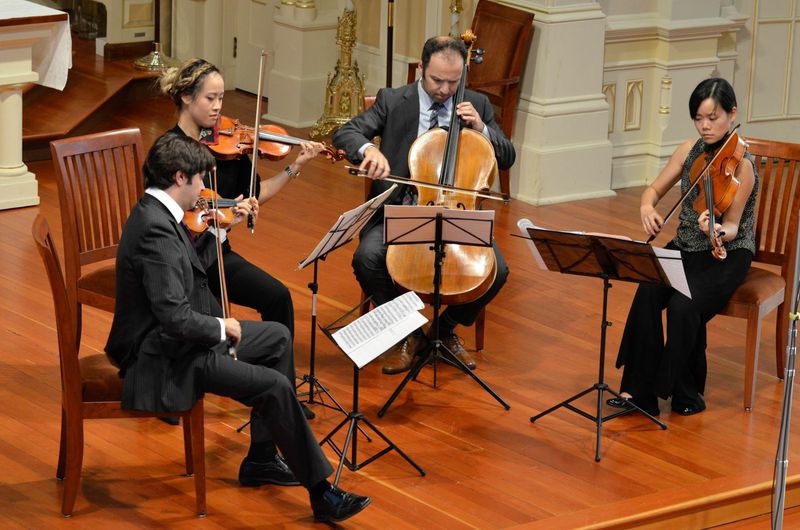Looking for faith in unexpected places.
The Berkeley City Club, a building designed by Julia Morgan and dedicated in 1930, is the jewel-like scene of a monthly chamber concert series, conceived and run by Joanne de Phillips as the Berkeley Chamber Performances. They inaugurated this year’s concerts on Tuesday, Sept. 21 with the Hausmann Quartet, an accomplished young foursome with a luscious sound and an experimental bent.
Their program put together a twentieth century rebel, a nineteenth century romantic, and a lovely contemporary work for an evening that began with a prank and ended with a prayer.
There was a sizable turnout despite some bad timing. Tuesday’s first game of the World Series put a small damper on this sophisticated event, with concertgoers furtively checking their cell phones as the lights dimmed. But as the quartet exploded into jazz scales and carnival flair in Louis Gruenberg’s Four Diversions, our imaginations left the Giants and the Kansas City Royals behind.
In Gruenberg’s work one could hear bits of ragtime, bits of Stravinski, a burlesque of bright colors in an everyday kind of madness. Isaac Allen played first violin with sharp top notes and rich depths. In the eerie and slightly sinister second movement his notes slurred and leaned on each other and then collapsed in a pile.
High violin scribbles were etched against the lowest notes of cello, amply supplied by Alex Greenbaum, who proved equal to the varied and exceptional demands of the program. After a slow pseudo-rhumba, the spotlight shifted to violist Angela Choong, whose exceptionally warm tone proved to be the heart of this ensemble.

And if Choong was the heart, newcomer violinist Melody Chang proved to be the flair, taking the first violin part in difficult Schumann runs and then in Kevin Puts’ stirring Credo. This violinist was surprisingly edgy in a quartet of long romantic gestures. Schumann’s less-performed Quartet in F-Ma Op. 41, No. 2 was a workout for the foursome, with gorgeous lines and unexpected joins.
And then came a present day masterpiece. After intermission (and an announcement that the Giants had hung onto their lead!) the Hausmann Quartet performed a work that will surely endure, and performed it powerfully. It began with harmonics and the sounds of tuning, high gestures and low simple chords, and then slowed to balance on that knife-edge between hope and devastation.
In a letter read by cellist Greenbaum, Kevin Puts described his choice of Credo for a 2005 commission, a composition that was meant to be “the lighter side of America.” He wrote the piece, he said, while “young lives and billions of dollars poured into a hopeless war [in Iraq] and millions marched with an appalled understanding that America was ceding its role as the best hope of mankind. Around this time a disturbed loner finally enacted his plan to gun down a record-breaking number of his fellow students at Virginia Tech.”
“One day I noticed the word ‘Believe’ emblazoned across a building. I later learned this was part of a campaign by the City of Baltimore, where ten percent of its population is addicted to either heroin or cocaine. Sometimes it seems all you can do is believe.”
“I have found solace in the strangest places,” wrote Puts.
Pieced together with modern daring amid quotes from Bach and the Latin Mass, his Credo was birthed in the pain of our history. But as I listened to the Hausmann Quartet perform its haunting last movement, I could also hear the song that Jews sang in the concentration camps, Ani ma’amim: “I believe with perfect faith/ in the coming of the Messiah/ And though he tarry/ Still I believe.”
After slow-bowed phrases finally stilled, there was a long minute of silence before people began to applaud.
For information on their next concert, see www.berkeleychamberperform.org
—Adam Broner
Photo of the Hausmann Quartet, from left: Isaac Allen, Melody Chang, Alex Greenbaum and Angela Choong; photo by Adrian Bonifacio at Noe Valley.
